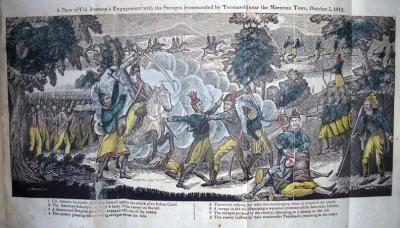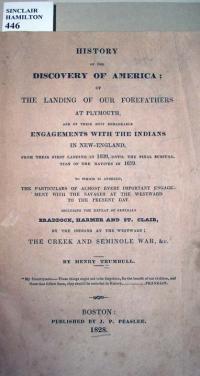Henry Trumbull, History of the Discovery of America (Boston: J.P. Peaslee, 1828). Illustrated with hand colored wood engravings by Abel Bowen. Graphic Arts, Hamilton 446.
The Boston printmaker Abel Bowen (1790-1850) has been listed in this blog before. The graphic arts division holds nearly ninety books illustrated by the artist. This volume contains three prints, one of which is the remarkable fold-out of “A View of Col. Johnson’s Engagement with the Savages (commanded by Tecumseh) near the Moravian Town, October 5, 1812.”
While crude, the print give a vivid account of the war between the native Americans led by Tecumseh (1768?-1813), chief of the Shawnee, and the U.S. cavalry led by Colonel Richard M. Johnson (1780 or 81-1850). These same three cuts are also found in the 1819 edition of the book published in Boston by Stephen Seweel and in editions published in Boston by George Clark in 1822, 1830, and 1831.
Tecumseh was a widely respected war chief, whose given name was actually Tecumtha or Tekamthi, meaning Celestial Panther Lying in Wait. In 1795, he refused to sign the Treaty of Greenville, which ceded much of present-day Ohio to American settlers. Instead, Tecumseh attempted to form a confederacy of tribes for the purpose of holding the Ohio river as a permanent boundary to white settlers. He did not succeed. During the War of 1812, he fought to support the British and received a commission as brigadier general.
For more information, see Colin Gordon Calloway, The Shawnees and the War for America (New York: Viking, 2007). Firestone Library (F), E83.775 C355 2007


For your information there is also a volume published by George Clark. J. Page, Printer 1832